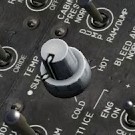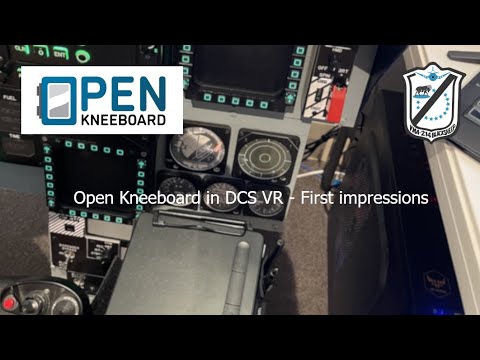I know I’m probably late to the party with this, but it was so amazing to me that I thought I should share it just in case. If you’re not already using OpenKneeboard in DCS VR (or I guess in 2D as well), it’s definitely worth checking out!
If you don’t want to read my wall-of-text raving, AnyTimeBaby has a nice first-impressions video including tablet writing functionality which I haven’t tried yet:
A couple years ago I tried using its (now deprecated) predecessor, VRK but found the performance hit was abysmal (probably due to my inadequate 7700K/1080 system at the time) and stopped quickly. I’ve always been a big fan of kneeboards in DCS*, and have really stretched the utilization of the OEM kneeboard to what I feel is it’s maximum extent, organizing aircraft folders with checklists and weapons cards for each module I fly (and many I should fly more), such as Minsky’s excellent Hornet Kneeboard Suite, as well as charts and map sections for each terrain. ED has made this easy to organize, and I applaud them for including this in the base game the way they have.
However, last week while playing through Baltic’s excellent Dominant Fury campaign, I found myself really struggling with organizing my kneeboard at the beginning of each mission. My procedure is during start-up to go through and shortcut/bookmark each page I think I’ll need during the mission; in my Hornet simpit there are a number of switches (video recording panel) that aren’t used/assignable in DCS that I’ve dedicated to kneeboard controls. Once I designate bookmarks on the pages I need, I can toggle the kneeboard and navigate through them easily using the ‘extra’ up/down switch on my Thrustmaster Hornet stick. Works pretty good, except that in complex missions sometimes there’s a lot of page-turning to find what I’m looking for.
In a Baltic Dragon mission, this typically consists of: Mission Cards, Target Photos, Aircraft Checklists, Specific Weapons Checklist (if required), and CASE III charts. Having to rush through to shortcut these each time a mission started was becoming a bit of a chore during startup, and then of course the kneeboard is a 2D object that’s standing up in your field of view any time you have it toggled on. While you can drag it around the screen with the mouse, its orientation is fixed and it’s kind of obstrusive.
Something made me think there had to be a better way, and I discovered OpenKneeboard had revived the VR kneeboard concept, and actually made it better than ever before! And with my new system, there’s zero appreciable performance hit, which was awesome. Installation was easy, and my favorite part is that you can now organize sections. It uses the default DCS kneeboard structure, and then you can add additional documents or sections beyond that as desired. The next-best feature is that now it allows the option of having two kneeboards at once, just like the latest release of BMS.
The other thing that’s cool is you can assign new control buttons in OpenKneeboard. Once I had structure I was happy with, I had to decide how I would control it in-game. Then it hit me: in my simpit I have a dual rotary encoder that I never use (at the time I wondered why I was going to the effort of hooking it up, but had already bought it so I might as well use it!):

So I assigned the bottom encoder to rotate through sections, and the top to pages. Works great, and if you have dual kneeboards it changes the one you’re looking at. Now I don’t have to bookmark anything, it’s organized so that I can go right to the section I want, and then to the page, and can swap between sections easily.
The pop-up gaze/magnification function works great, and even with it off the kneeboards are sized large enough to read clearly in VR with my Reverb G2, unlike the stock DCS kneeboard. There’s also a radio log tab that is wonderful when working with a JTAC or punching in coordinates from a wingman. Anyway, enough (more than) said, if you’re not already using it in VR, it’s definitely worth checking out. I rate it as indispensable now, right up there with Simshaker, SRS, and Vaicom for me.
*Funny anecdote about kneeboards in real life civilian flying:
In my previous job as a captain for a charter/corporate outfit with a fleet of about 25 Citation Jets and King Airs, I was often paired with new-hire FOs who had just been typed or checked out in the right seat of various aircraft and were pretty wet behind the ears. For most of them it was their first ‘real job’ after flight instructing at the local aviation university we recruited from. I always enjoyed getting the opportunity to introduce them to line flying in the real world, and showing all the little tips, tricks, and traps that you didn’t learn in a training environment. Since I wasn’t involved in the training department, generally the first time I’d meet them would be at showtime on day one of a trip.
I learned rather quickly that if one of them proceeded to strap on a kneeboard after entering the cockpit, it was going to be a long day, or a series of long days. There’s nothing inherently wrong with a kneeboard; they’re a convenient way to keep notes, reference navlogs, or manage charts (30 years ago). I’ve used one when doing aerial survey work and animal tracking operations where I had to write down coordinates or do FM homing. That’s all well and good, but in a corporate jet there’s not really much need for it; we didn’t have paper charts anymore, didn’t really keep navlogs unless oceanic (Gulf of Mexico) and if your clearance can’t be jotted down on a sticky note (the free hotel ones were the best!), there’s something wrong.
The FO’s that brought their kneeboards turned out to be dependent on writing down everything. Apparently the kneeboard thing was something being pushed by the flight school, it seemed to be pretty universal. One wrote everything down long-hand (imagine writing down CRAFT, except "CLEARANCE- ROUTE-, etc), resulting in a 3-page novel each leg, laboriously copying down clearances and re-routes, even writing down frequencies and altitudes instead of plugging them into the panel right away. Sounds benign, but it resulted in everything taking twice as long, and the FO getting further and further behind the airplane. When center calls you back before you give a readback because you’re still writing, that’s a problem. I’d keep telling them to stop writing so much and focus on the ‘doing’ part, but it was an ingrained behavior.
Finally, I got to the point where I’d ask them before they ever even got in the cockpit “Do you have a kneeboard?” If they replied yes, I’d politely tell them to go put it back in their car, they won’t need it in our operation and try to explain how it just tended to hamper them in the cockpit. It was a crutch that turned into a boat anchor when you’re flying the kind of equipment that we were. You can’t imagine how crestfallen a new FO on their first line trip looks when the captain greets them in the parking lot and makes them take their kneeboard out of their flight bag, but it really was a real thing, and making the kneeboards go away quickly fixed the problem.
Plus the straps wrinkled their dress pants! ![]()

